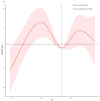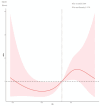Association of dietary inflammatory index with liver fibrosis and fatty liver index in a population with metabolic dysfunction-associated steatotic liver disease: A cross-sectional study
- PMID: 40630170
- PMCID: PMC12236103
- DOI: 10.3389/fnut.2025.1594192
Association of dietary inflammatory index with liver fibrosis and fatty liver index in a population with metabolic dysfunction-associated steatotic liver disease: A cross-sectional study
Abstract
Background: Hepatic fibrosis and the fatty liver index (FLI) are critical indicators for assessing the progression and severity of metabolic dysfunction-associated steatotic liver disease (MASLD) and serve as valuable reference markers for predicting MASLD-related risks. The Dietary Inflammation Index (DII) quantifies the inflammatory effects of dietary intake and has been extensively utilized in nutritional and epidemiological studies. Although studies have been conducted to confirm the correlation between dietary quality and MASLD in the general population, this study sought to further explore the association between the DII and key indicators of liver disease severity-namely hepatic fibrosis and the FLI-within a cohort diagnosed with MASLD. In addition, the potential mediating role of the systemic immune inflammatory index (SII) in these associations was also investigated.
Methods: This cross-sectional study was based on data from the 2017-2020 cycles of the U.S. National Health and Nutrition Examination Survey (NHANES), a nationally representative program designed to assess the health and nutritional status of the population. In this study, we analyzed the correlation of DII with FLI and liver fibrosis in a population of patients with MASLD by linear regression, logistic regression, RCS curves and subgroup analysis. A mediation model was applied to assess the potential intermediary effect of SII on the associations between DII, FLI, and hepatic fibrosis.
Results: The results of this study indicate that, after adjusting for all covariates, the Dietary Inflammatory Index (DII) was not significantly associated with the Fatty Liver Index (FLI) among U.S. adults with MASLD (β = 0.32, 95% CI: -1.393 to 2.034, P = 0.631). Similarly, no significant association was observed between DII and the risk of liver fibrosis (OR = 1.152, 95% CI: 0.885 to 1.499, P = 0.210). Subgroup analyses further demonstrated that these associations were not modified by demographic or metabolic stratification variables, and the relationship appeared to be nonlinear.
Conclusion: In U.S. adults with MASLD, no significant association was found between DII and the risk of liver fibrosis or elevated FLI. Although DII is linked to various chronic diseases, its role in MASLD appears limited and non-specific, particularly in capturing intermittent disease progression. No mediating effect of SII was observed. These findings underscore the importance of carefully considering dietary factors in the clinical evaluation of MASLD progression. The potential relationship between diet and liver disease progression warrants further investigation.
Keywords: Fatty liver index; MASLD; dietary inflammatory index; hepatic fibrosis; systemic immune-inflammation index (SII).
Copyright © 2025 Sang, Wang, Leng, Huang, Sun, Wang, Liu and Deng.
Conflict of interest statement
The authors declare that the research was conducted in the absence of any commercial or financial relationships that could be construed as a potential conflict of interest.
Figures
Similar articles
-
Association between Life's Crucial 9 and metabolic dysfunction-associated steatotic liver disease: the mediating role of neutrophil-percentage-to-albumin ratio.Front Nutr. 2025 Jun 6;12:1549089. doi: 10.3389/fnut.2025.1549089. eCollection 2025. Front Nutr. 2025. PMID: 40547368 Free PMC article.
-
Association of the dietary index for gut microbiota and dietary inflammation index with metabolic dysfunction-associated steatotic liver disease and metabolic alcohol-associated liver disease.Front Immunol. 2025 Jul 17;16:1593245. doi: 10.3389/fimmu.2025.1593245. eCollection 2025. Front Immunol. 2025. PMID: 40746546 Free PMC article.
-
Elevated serum parathyroid hormone predicts metabolic dysfunction-associated steatotic liver disease (MASLD) and progressive fibrosis.Nutr Metab Cardiovasc Dis. 2025 Jun 24:104208. doi: 10.1016/j.numecd.2025.104208. Online ahead of print. Nutr Metab Cardiovasc Dis. 2025. PMID: 40651886
-
Systemic pharmacological treatments for chronic plaque psoriasis: a network meta-analysis.Cochrane Database Syst Rev. 2017 Dec 22;12(12):CD011535. doi: 10.1002/14651858.CD011535.pub2. Cochrane Database Syst Rev. 2017. Update in: Cochrane Database Syst Rev. 2020 Jan 9;1:CD011535. doi: 10.1002/14651858.CD011535.pub3. PMID: 29271481 Free PMC article. Updated.
-
Systemic pharmacological treatments for chronic plaque psoriasis: a network meta-analysis.Cochrane Database Syst Rev. 2021 Apr 19;4(4):CD011535. doi: 10.1002/14651858.CD011535.pub4. Cochrane Database Syst Rev. 2021. Update in: Cochrane Database Syst Rev. 2022 May 23;5:CD011535. doi: 10.1002/14651858.CD011535.pub5. PMID: 33871055 Free PMC article. Updated.
References
LinkOut - more resources
Full Text Sources




